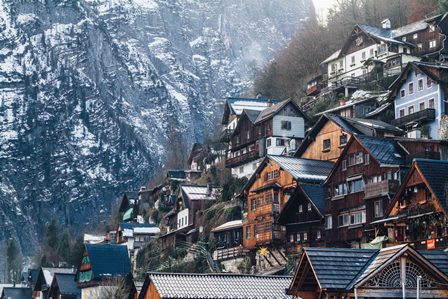
(Photo by Riccardo Breciani)
Real mountains near communities can have an influence on the people, above and beyond the obvious mundane things we know to be true, like fire hazards and proximity to wildlife. In the olden days, it was considered dangerous to live on top of a mountain because of the remoteness of the location in case of an emergency. Likewise, a house at the bottom of a mountain was in direct danger of flooding and avalanche. This still happens all the time and I often wondered about the La Conchita community, up against the mountains in Santa Barbara, long before they had their land slide.
Mountains can be interpreted based on their shape as well as their abundance or lack of greenery or animals. A mountain that is nothing but rock can be referred to as a yin mountain. When a mountain cannot or does not sustain life, we can see how the people who live nearby may be poor or despairing.
When a mountain has oily green plants and sustains animals of any kind, then the qi (energy) is good and it is called a yang mountain. The people who live near yang mountains will be healthier and more prosperous. In this instance, the term yin refers to stillness and lack of life and movement. Yang here refers to activity and life and a nurturing quality.
When mountains are soft and rolling, the life of the people nearby will be easy and the people may even be more attractive. When the mountains are rough and jagged looking, the people living nearby can have many hardships.
In classical Xuan Kong Feng Shui, we learn that there are four major house types. And out of those four major house types, two of them can benefit from having a mountain in front of them, while the other two can benefit from having a mountain behind them. It is common to hear or read that the ideal good Feng Shui house has a mountain behind it, but this is an overly simplistic understanding of the theories. Some houses need a mountain in front of them to improve the health and well-being of the occupants.
We also have a concept or term called a “virtual mountain.” The virtual mountain is a real structure, just not a real mountain. An example of a virtual mountain could be a house across the street from another house. If the house is taller, an additional story, then it can be a virtual mountain in relation to the smaller houses around it. Some of my professional peers disagree on whether another structure can work as a virtual mountain. While being made partially from earthen materials, and having the necessary height, a building is hollow inside and people are living or working inside. So, it is really not an adequate replacement for a real mountain or hill. It would be considered too “yang.”
When a landscape is built up with rocks, boulders, elevated flower beds or even brick walls, this elevated earthen feature can also be called a virtual mountain. This becomes a real blessing when a house needs a mountain on the property and there is no way to control what your neighbors do. At least on your own property, front or back yard, you can create a virtual mountain with a number of landscaping techniques, such as the ones described.
The term mountain can also refer to a directional area. For example, when we use a compass, we can refer to the twenty four mountains that distinguish the twenty-four different possible sitting directions of a house. The twenty-four mountains each have a 15-degree range and that is what totals the 360 degrees surrounding a compass.
For example, the whole range of east is a 45-degree range. But we can break that whole sector of east into three separate 15-degree increments. We can call them “east-1,” “east-2” and “east-3.” These are three different “mountains.” Knowing the precise compass orientation of a structure, and knowing which “mountain” the house sits in, helps us determine if the house should have a mountain formation on the front or back side. This is combined with the year the property was built, for a blending of time and direction.
We have a term in classical Feng Shui called “wang shan,” which means “strong mountain.” It is a metaphor for the people being healthy and happy. In Feng Shui folklore, much has been written about the fate of the people nearby a mountain that was cut into without respect for the “dragon veins.” The dragon veins are lines or currents of energy, almost like meridian points for the natural landscape. When we bulldoze into mountain sides with modern construction and freeway projects, we may or may not be doing damage to the natural energy currents passing through the mountains.
This article was written on the eve of a big event in Southern California, where the next day the Mulholland bridge was partially taken down and the freeway section in this area of the 405 freeway was closed for two days. The Los Angeles Times reported that the 405 freeway originally opened in 1962, with photos of what the freeway and surrounding mountains looked like just after completion. How about the series of tunnels on the 110 freeway that connects downtown Los Angeles to Pasadena?
The burrowing through the mountains to create these tunnels was definitely a huge disturbance to the energies of the mountains. Folks reading this article who live in the Los Angeles area are very familiar with these mountains and I, for one, often think about the mountain qi whenever I use these freeway systems. Sometimes it appears that “man” can conquer nature when we see these architectural feats, but as we know, this is never true in the long term. In a contest between nature and man, nature will always win.
Author: Kartar Diamond
Company: Feng Shui Solutions (R) Since 1992
From the Landscape and Exteriors Blog Series
